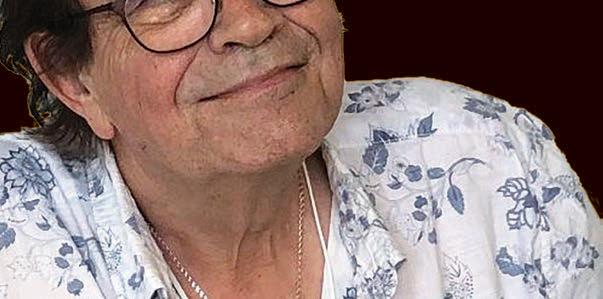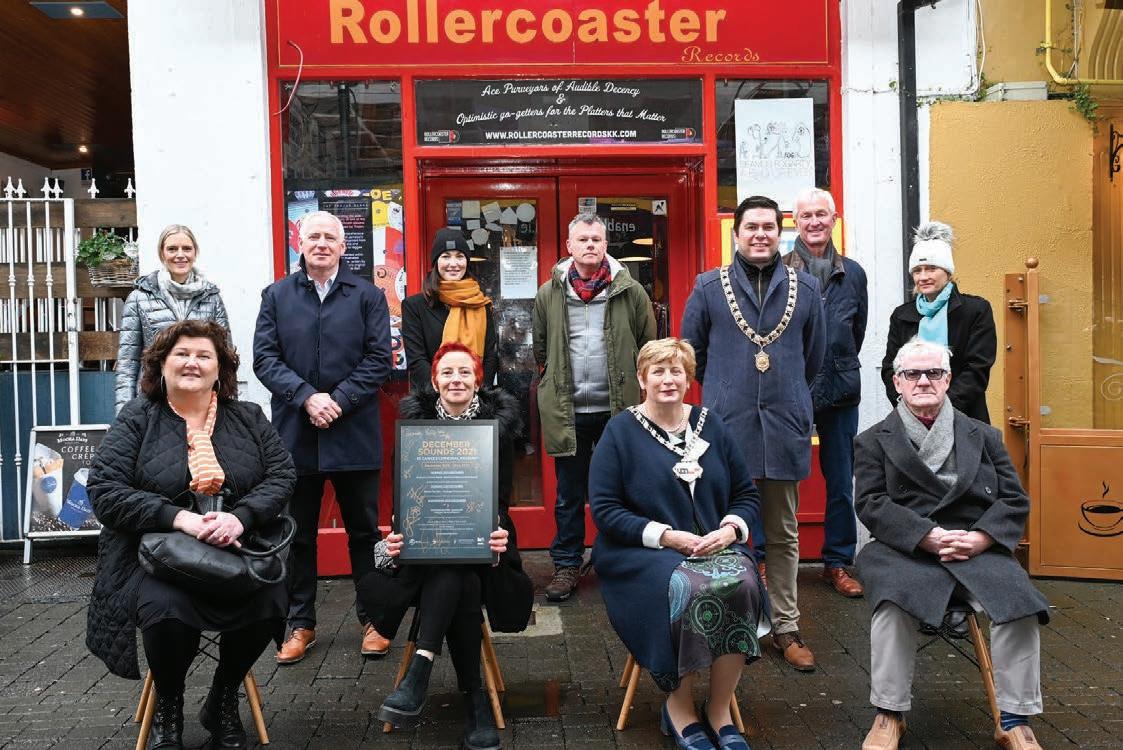
11 minute read
Paul Hopkins
The Fact OfThe Matter

Advertisement


PAUL HOPKINS PAUL HOPKINS When women in fear live every day with a plan
Four years ago when she was 15, Helen’s friend, a year older, enticed her into his house, when his parents were out. After some small talk he pounced on her and attempted to remove her clothing. Helen, thankfully, managed to fend o her attacker and ee.
Her mother, a lone parent, confronted the boy’s parents in no uncertain terms after her daughter came home in tears, shocked and dishevelled. e attack was not reported. “It would have been his word against mine,” Helen tells me. “Who would they believe?”
Dee is my age. Married in the Seventies, she lived in Paris. “On the Metro, men were exposing themselves. My friend was stalked for two years. A lot of women were harassed. It was a nightmare.”
Dee has lived on her own since her divorce. Her son and two grandsons live in London. She is in rural Ireland. “Am I afraid living on my own? Often I am scared to answer the door. Often it is men saying tiles are missing on my roof and they’ll x it. ey see I am an elderly woman on my own and want to take advantage.”
Recently Dee was having her car serviced. “In the garage, the salesman, about 50, was ddling with his phone. ‘Come ‘ere, look at this,’ he said and pointed his phone at me. ‘What do you think of that, eh?’ He was laughing, this face ushed. It was pornography on his phone.”
Meadhbh is 38. “Cases like we’ve heard of in the last weeks are a reminder of the collective threat and valid fear women the world over live with. It’s always there, underneath, some days even subconsciously — a quickened pace, an averted gaze, a fake phone call. Anytime you have a ‘strange’ taxi man you feel it, or get caught in the dark somewhere.
“ e worst part is we grow up almost with acceptance, it’s second nature, to always be on your guard,” she tells me. “Stories like Ashling Murphy are a timely reminder how real those threats can be.
“ e good men, most men, need to be part of helping change the threat, the culture. It starts with refusing to laugh at stupid jokes; it starts with stamping out cat calling. ere’s a long way to go.” is writer has talked to many other women the past days, in light of the murder of Ashling Murphy at 23. Shockingly, it is the case that, of all the women I asked, all have ‘a plan’. e ‘fear’ is always a low hum beneath the rhythm of their regular life, implanted in early teenage years. Although, statistically, violent crime is committed on men more than women — 70% to 30% — women are more afraid. “You’re afraid a strange man will attack you,” says Helen who is doing her Leaving Cert this year.
So, women don’t run at night. Women don’t park in an out-of-sight car park. Women don’t enter a lift already occupied by a single man in an unfamiliar building. Women don’t leave a party without their friends. e Dublin Rape Crisis Centre dealt with 13,367 calls in 2020, the latest gures available. ree in four were from females. Of those who disclosed their details, 44.8% said they had been raped, while 33% were victims of childhood sexual abuse.
Almost a quarter of Irish women avoid certain streets for fear of being assaulted or harassed, according to a recent EU study. e study by the EU’s Fundamental Rights Agency shows 23% of Irish women “deliberately stay away from particular locations often or all the time to reduce the risk of attack”. Ireland’s nding is the second highest among the 27 states after Greece at 29%.
e gure is even more pronounced among Irish women aged 16 to 29 with 45% taking such action “to avoid being attacked either physically or verbally”.
A young woman, who reported a rape and is awaiting a trial in the case, says she has a “nightmare” about her choice in underwear being submitted in evidence by the defence. “I am terri ed. What are they going to do to me in court?” she says.
“Every day women live with the fear,” says Ella. “It’s not paralysing but it’s omnipresent — whether out walking alone or, when pubs were open, asking a friend to watch your drink while you go to the loo. Women feel like ‘it’s all my fault if something happens to me’.”
Ella turned 21 in December. She has her whole life ahead of her.
Will she always need ‘a plan’?



Nearly 1,000 driving arrests over festive period
AN Garda Síochána’s Christmas and New Year Road Safety Campaign for 2021 started on Friday, November 26 and ended on Tuesday, January 4, 2022. e campaign primarily focused on Mandatory Intoxicant Testing i.e. detecting those who drive under the in uence of alcohol or drugs. e campaign also focused on speeding, non-wearing of seatbelts, mobile phone use by drivers, in addition to checking on unaccompanied drivers driving on learner permits.
For 2022, Assistant Commissioner Paula Hilman, Roads Policing and Community Engagement Bureau continues to appeal to all road users to prioritise road safety. “As we enter 2022 our thoughts are with the families of the 134 people who lost their lives on our roads during 2021.
“An Garda Síochána are committed to reducing deaths on our roads in 2022 and are asking all road users to make this their priority too. While a large majority of the public listen and comply with road safety advice we want all road users to be safe.”
Assistant Commissioner Paula Hilman said, “Over the Christmas period, Gardaí arrested 914 drivers for Driving While Intoxicated, approximately 1 in 5 (21%) drug driving arrests occurred between 6am and 1pm. 35 Drink and Drug Driving incidents occurred on New Year’s Day, 12 of the incidents occurred between 6am-1pm, that’s a poor start to 2022 for some drivers. ere were 13,950 speed detections over Christmas, while 1,269 FCN’s were issued to drivers using mobile phones and 525 FCN’s were issued to learner drivers, driving unaccompanied.” Sam Waide, Chief Executive, RSA said, “I would like to acknowledge the tremendous enforcement e orts from An Garda Síochána in 2021 and over the Christmas period, in addition to road users behaving safely. However, it is astonishing to see the numbers of those who persist to drink and drug drive, as it signi cantly increases the risk of a fatal collision.”

Concerts raise over €5.5k for local charities

DURING one of the most challenging years in the music and live events industry, an incredible €5,862 was raised for local charities during the December Sounds concert series held at the magni cent St. Canice’s Cathedral as part of Yulefest Kilkenny.
Concerts were capped at 50% and social distancing was in place. Changes to restrictions in the days leading up to the opening night on December 20 didn’t impact the support from concert goers who attended one of Kilkenny’s most remarkable venues. Artists were quick to accommodate the earlier curfew, shortened sets and were delighted to be performing the nal concert series of the year in Kilkenny. “An honour and a privilege to be part of December Sounds,” said artist, David Keenan.
Local Kilkenny charities Ciara Lawlor Memorial on behalf of the Irish Wheelchair Association, Cois Nore, the Aislinn Centre, Chernobyl Kilkenny Outreach Group, Amber Women’s Refuge and the O’Neill Centre bene ted from the ticket sales.
Cathaoirleach of Kilkenny County Council Council, Cllr. Fidelis Doherty, commenting on the success of the initiative said, “It was uplifting to hear lovely live music and due to the generosity and goodwill of people, local charities have been able to enhance their various programmes of works. A big thank you to all involved for organising December Sounds and making it the success it was. After a very di cult year the initiative made Christmas time extra special for the people of Kilkenny.” e lineup across the three nights included Cormac Begley, John Francis Flynn, Liam Ó Maonlaí, Bird On e Wire, Elise, Seamus Fogarty, Malojian and David Keenan.
“I can’t praise organisers enough for how perfectly ev-
Pictured at the cheque presentation, back L-R: Eimear Phelan (Irish Wheelchair association), Director of Services Kilkenny County Council Tim Butler, Event Manager Andrea Keogh, Gary Kehoe (Rollercoaster Records), Mayor of Kilkenny Municipal District, Andrew McGuinness, Bill Cuddihy (Cois Nore) & Eimear Lawlor (Ciara Lawlor Memorial Fund). Front L-R: Jean Murphy (Amber Women’s Refuge), Arts O icer Mary Butler, Cllr. Fidelis Doherty and Jim Kavanagh (Chernobyl Children Kilkenny). Photo: Vicky Comerford.
erything was arranged at the December Sounds concerts,” said Mayor of Kilkenny Municipal District, Cllr. Andrew McGuinness, “St. Canice’s Cathedral looked fantastic, the lineup was a real treat and combined with the outstanding sound quality courtesy of Broderick’s Music, Kilkenny, it was the perfect setting. Huge credit to Event Manager, Andrea Keogh and her team, for going above and beyond to deliver events like this for us to enjoy.”
Kilkenny group launched to support LGBTQ+
THE Kilkenny-based Project DAVID (Diversity Awareness Visibility Inclusion Development) has been launched to address a lack of visibility around the LGBTQ+ community in rural Ireland.
While the focal point will be the Kilkenny area, there are plans to branch out across the south-east region with mental health workshops. e Twilight Community Group, an organisation focused on promoting inclusion, created the Kilkenny based project to not only raise awareness but also support the LGBTQ+ community in speaking out against issues which may a ect them. ey are taking numerous approaches towards achieving this, such as hosting intergenerational peer support groups, disseminating information through a digital hub and launching a podcast titled Courageous Conversations.
Across the span of six months, Project DAVID aims to empower the LGBTQ+ community in rural Ireland by creating accessible support systems and intergenerational conversations. ese mental health workshops and groups were developed through the Twilight Community Group’s collaboration with organisations such as Mental Health Ireland as well as Translife Kilkenny.
Speaking about this new initiative, Project DAVID Team Lead, Karen Hughes, said, “What I’ve learned from talking to people from the LGBTQ+ community in Kilkenny is that there’s zero visibility and even less awareness of the challenges faced by the community … Ultimately, I want this project to break the stigma around the LGBTQ+ community and make Kilkenny a safe place for people to be themselves without the fear of being ostracised. “ is project is going to put the issues faced by the LGBTQ+ community into the public sphere and create an awareness of them, not only will it create an awareness but it is going to o er support to people in the community.”
Project DAVID are inviting people to take part in their activities. “ is could be through doing interviews (podcast style and video) about their experiences of being from the LGBTQ+ community, especially if they are from Kilkenny themselves,” said Karen. “We also need people to be a part of our peer support groups.”
Study nds female politicians targeted in Twitter threats
OVER 38,000 threats toward politicians were identi ed in tweets, a new study has found. ere were also 15,842 sexually explicit comments and 77,040 insults. “Toxicity” was identi ed in 72,552 tweets and “severe toxicity” was found in 26,866 comments. e research by Dr Ian Richardson found there was no gender divide in the amount of abuse aimed TDs. ere was a signi cantly higher level of abusive messages focused at female councillors and senators than at their male counterparts.
“When accounting for the number of followers a politician has, female Local Councillors received eight times as many abusive tweets per followers compared to their male counterparts, while female Senators received three times as many abusive tweets per followers than their male counterparts,” the report nds.
In his conclusion, Dr Richardson says, “ e trend which is of most concern to achieving a truly representative democracy is the level of abuse women in the traditional paths to becoming legislators (local councils and the Seanad) receive compared to men. Considering the number of newspaper articles published regarding abuse towards politicians on social media, it is not a stretch to suggest that this may be a barrier to women entering politics.”
Male politicians serving in Government were found to receive far more abuse on Twitter than men in opposition parties.
Dr Richardson’s research was conducted using publicly available arti cial intelligence software combined with computer programming code he wrote himself to determine the level of abuse politicians encountered on Twitter.
His research found the “most proli c abusive accounts”, were a liated with Sinn Féin, Fine Gael and Independents respectively.








